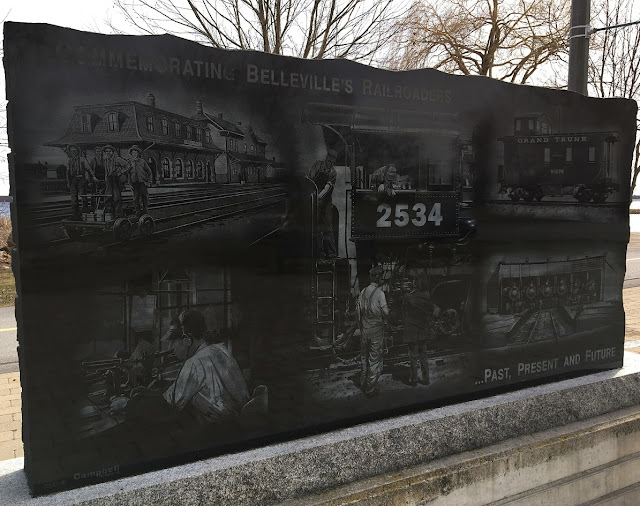Rooted In Railroading
Billowing smoke
and sputtering black soot generously showered the cheering group of spectators
eagerly awaiting its arrival as it slowly and noisily lumbered into the local
train station in the fall of 1856.
To Belleville
residents it was a much-anticipated event that would forever drastically alter
the history of the community’s progress.
The joyful news
was first reported in the Oct. 31 edition of the Hastings Chronicle that year.
"Belleville
has at last been placed upon the great highway of the Province by the opening
of the Grand Trunk Railway. The first regular trains from the East extending to
Portland in Maine, through Montreal, and from Stratford, West, being 855 miles,
made their first stop in our good Town, on Monday last, to the no small
pleasure and gratification of the of a large number of our citizens."
This was an
event that laid the foundation for the enormous role railroading would
eventually play in the lives of the people in the area. Local farmers benefited
greatly from the opening of the new means of transportation that would help
them get their product to greater distances any time of the year and in a way
never before experienced by their ancestors who had also worked the land for
their living. The arrival of the locomotive brought with it an introduction to
a way of life that soon pervaded the very fabric of this community when, soon
after, Belleville became a divisional headquarters for the Canadian National
Railway transforming the town into an important railway community.
In 1910, a
41-stall roundhouse was built at the Belleville railway yard providing more
employment opportunities to local men looking to work in railroading. Alongside
them were members of the train crew that used to work at the little York
roundhouse that closed in 1905.
According to
Keith Hansen, author of Last Trains From Lindsay, and a railroad
historian living in Warkworth Ontario, the 1910 Belleville roundhouse was
predated by the original Grand Trunk "roundhouse" which was square
and completely closed.
"It was
sited south of the present VIA station and I believe it was the lower part of
one wall of that structure which, for many years, deceptively appeared to be a
stone fence wall on the north side of the street just west of the VIA station.
A second "roundhouse" was added to the east of the first. With engine
size growing by leaps and bounds those two buildings became untenable leading
to the construction of the 1910 facility."
The 1910
structure was at one time in the form of a complete circle with an entrance
space on each of the west and east sides. "Its function, like that of the
other roundhouses on the CNR system, was to provide for the daily repairs and
maintenance necessary to keep locomotives available for their duties. It wasn’t
fitted to do major overhauls. That kind of work was done in CNR shops located
in Moncton, New Brunswick, Point St. Charles in Montreal, Stratford, Ontario
and Transcona, east of Winnipeg, Manitoba. The largest roundhouse on the whole CNR
system was at Turcot west of downtown Montreal."
Larger engines
came along and the need for all the existing stalls declined with time. Some of
the stalls on the south side were taken down by 1953, he noted.
Steam trains passed into history when replaced
by diesels in the early 50s. Since diesel engines did not require the same
amount of maintenance as the coal-fired trains did, many city residents working
in the railway lost their jobs when the final switch was made. The transition
eventually sounded a death knell for the roundhouse, a precious inheritance
from the heydays of railroading in Belleville in the 1930s. Major demolition of
the roundhouse began in December 1960, leaving behind just nine stalls. Part of
the roundhouse and the turntable existed until recently and were completely
taken down in 1997. The existing railway station in Belleville is what remains
of the building constructed in 1855 and is, today, one of the only two original
Grand Trunk Railway stations left in the province today. The other one is in
Prescott, Ontario.



Comments
Post a Comment